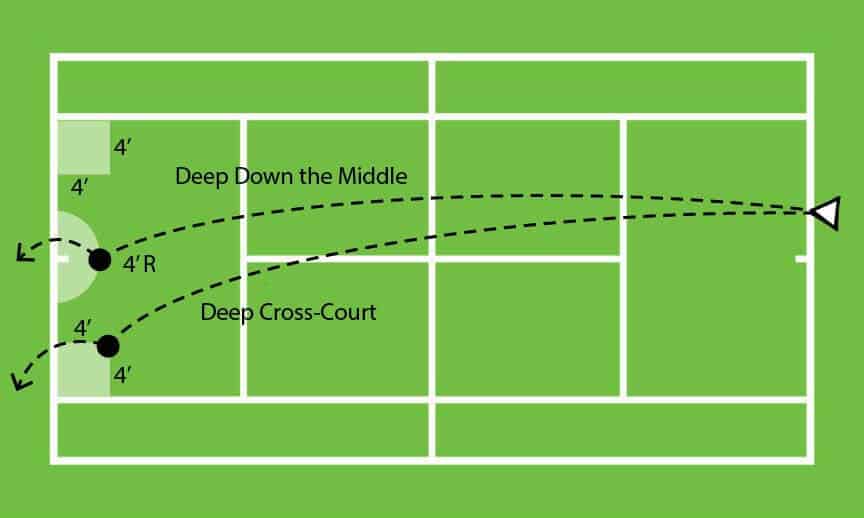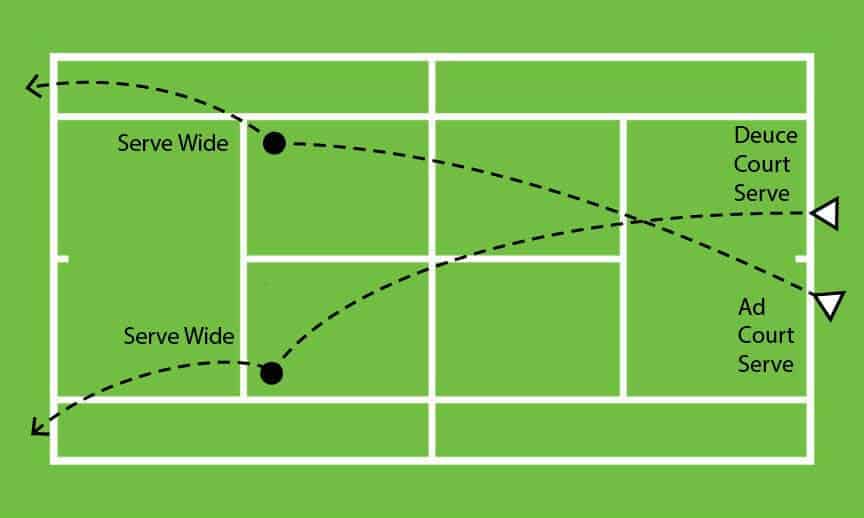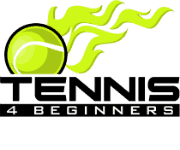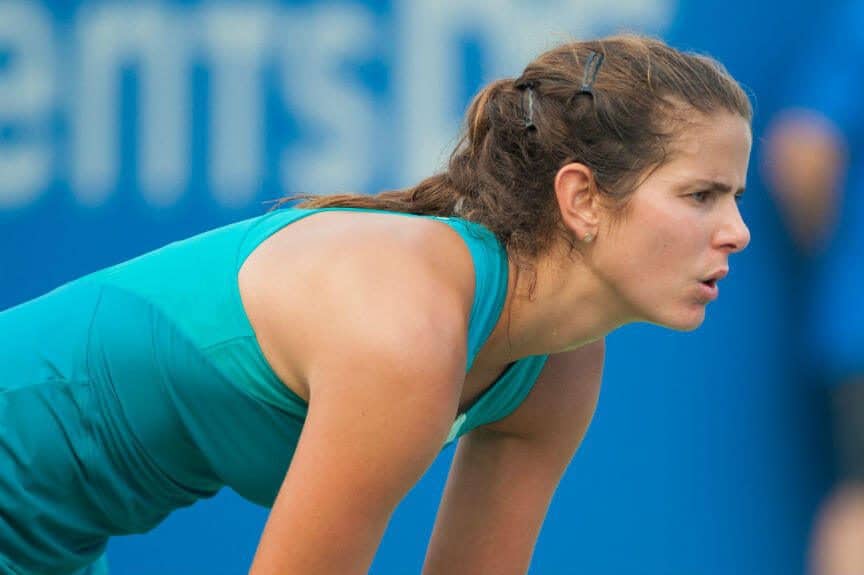From a fundamental standpoint, winning in tennis comes down to two things: win more points than your opponent and make fewer mistakes. However, to get there you need a solid strategy and tactical game plan.
Strategy in tennis is the key to winning or losing. If you come well prepared with a solid strategy, you greatly increase your chances of winning. Even before a match begins, you should already have a clear idea of what your approach will be.
If you don’t know your opponent and what their strengths and weaknesses are, you need to start analyzing them from the time they begin warming up. During the first few minutes, you will have a definite opportunity to scout them.
It’s not uncommon for recreational or club players to come in with no strategy in mind. And believe it or not, it is even common for players at this level to play a full match simply going through the motions without ever strategizing.
While playing with confidence in your ability to execute your own game is very important, and we will cover this aspect in detail, it is also important to have a strategy in place that will allow you to exploit your opponent’s weaknesses and not play into their strengths.
I should note that analyzing an opponent is different from focusing your attention so much on them that you get distracted. You want to analyze them, but remain fully focused on your own tactics of play. We’ll begin by taking a look at how to best implement this strategy.
Concentrate On the Ball Not Your Opponent
One of the fundamental mistakes players often make is focusing too much attention on their opponent. Remember that at the end of the day you are playing the ball, not your opponent. Sure, you need to gauge where they are going to go next, however, your eyes should remain locked on the ball itself.
By focusing on the ball you are less likely to be distracted by some of the tactics players use to disguise their shots. You are able to better react to what the ball is doing, whether it is coming at you with topspin or slice, or whether it is a floater coming your way.
Your opponent sets up the shot, but you have no control over what they do. You can control the ball, on the other hand. Where you strike it, whether you use topspin or slice or no spin at all. Whether you hit on the rise, in front of you, etc. These are the things you can control.
One misconception is that staying locked on the ball will not allow you to read all the subtleties that are occurring on the court. However, the fact that you are locked on the ball doesn’t necessarily mean that you can’t pick up on cues as to where the ball is going.
Your eyes have the ability to see peripherally, despite your primary point of focus. As a result, you will be able to process everything simultaneously. You’ll notice that by focusing on the ball, you’ll be more “in the zone” during matches.
The key is to eliminate unnecessary distractions and focus instead on the things that actually do affect the game. By maintaining your focus on the ball, you will go a long way in achieving just that.
Hit Consistent Deep Balls

If there is one strategy you should use consistently, it’s hitting deep into your opponent’s court. If you are able to do this consistently throughout a match, you are almost guaranteed to win. This assumes, of course, that you have a good serve to go along with your groundstrokes.
The reason players fail to achieve this is that, unless you are a professional, it’s very difficult to hit deep with regular consistency. Your goal, therefore, should be to be as consistent as possible with your deep balls. At the very least, you want to be more consistent than your opponent.
You want to give yourself some margin for error, so aiming for about 4 feet from the baseline is usually a good reference point. If you are hitting down the middle, imagine a 4-foot semi-circle in front of the centerline mark along the baseline.
If playing to the corners of the court, imagine a 4-foot square from the corner of the baseline and sideline. Aim for the corner of the squares on a consistent basis. This will give you enough margin for error. Don’t aim for the line, if your ball hits the line it should not be intentional.
After your shot, be sure to get back in position in the center of the court as soon as you are done hitting the ball. Don’t wait and do not admire your shot. It’s important to get back into position as soon as possible so you are prepared for your next shot.
The ideal position when preparing for your next shot is going to be halfway between where your opponent can hit to your forehand or to your backhand. Note that this will not always be the center of the baseline.
For example, if you’ve played the forehand corner of your opponent’s side, your positioning should be right of the center mark. If on the other hand, you have played to their backhand corner, position yourself left of the center mark.
Play High Percentage Groundstrokes
On groundstrokes, your highest percentage shot is going to be cross-court. There are a couple of reasons for this. First, you allow yourself more length in the court than if you go down the line or down the middle. Second, the net is lower in the middle, so you increase the likelihood of making it over the net.
You should aim to go cross-court at least three times for every time you decide to go down the line. You can use the down the line shot to mix things up a bit from time to time, but remember that the court gets shorter and the net higher when you go down the line, so go for the higher percentage shot 7 out of 10 times.
Down the middle is a secondary strategy you can use, particularly on your first shot in order to establish depth. Since the net is shorter in the middle, you give yourself a better chance than if you were going down the line.
After establishing depth, begin to work the corners of the court. You now want to move your opponent around. If possible, try to play your forehand as much as possible (assuming this is your strongest groundstroke). Run around the backhand if necessary.
You increase your groundstroke percentages if you use your more reliable groundstroke. For most players, that is going to be the forehand. As long as you get set quickly after hitting your shot, you should be able to use 2/3 of the court to play your forehand.
Avoid the Shots You Haven’t Mastered
On the other hand, you want to avoid hitting shots that you are not comfortable with. If you want to increase your chances of winning points, use the strokes that are your strongest asset. If your forehand is stronger than your backhand, run around the backhand to hit a forehand.
You will not always be able to do this, but when presented with the opportunity, make the move to put yourself in a better position to make the shot. If your backhand is stronger than your forehand, play it more often.
On critical points, avoid shots you are less comfortable hitting. You are better off hitting a good shot cross-court than trying to burn your opponent down the line. If you are not comfortable hitting a drop shot or lobbing the ball or volleying, go with your strongest shot.
If your opponent forces you up to the net and you are not a strong volleyer, try to hit the shot you are most comfortable with given the options available to you. Try to position yourself so you hit a forehand volley, assuming that’s your stronger side. If you are better hitting volleys cross-court, that’s the shot to go with.
While having as many shots to your disposal is ideal, the truth is you only need a few shots that you have fully mastered as long as you stick to them without trying to get fancy. If you combine that with playing to your opponent’s weaker shot, you’ll put yourself in a strong position to win.
Force Your Opponent to Use Their Weaker Shot
Your goal should be to exploit your opponent’s weaknesses as much as possible while limiting your strokes to only those you have mastered. Put your ego aside and avoid fancy shots, especially on key points during a match.
Chances are, your opponent will have a weaker backhand than forehand, so play deep to their backhand to exploit this. Of course, if you are going cross-court, this will likely mean you will be playing your backhand as well unless you run around it.
If they are uncomfortable playing up at the net, bring them up to the net. You should spend the first few minutes of a match studying your opponent’s weaknesses so you are better prepared. In fact, during warm-ups, you should already be assessing their weaknesses and strengths.
From there, your focus should be to avoid hitting to their strengths and loading your shots to their weak side. If your opponent seems to have no obvious weaknesses at first glance, experiment with different shots to find where they are less comfortable.
You should also be testing out their strike zone. Most players have an ideal strike zone, where they make the best contact with the ball. If that strike zone is above the waist, hit them low balls or slice to make them uncomfortable.
If they prefer to hit their shots low or below the waistline, hit some heavy topspin shots that carry well over the net. This may be enough to throw off their mechanics and give you an upper hand.
Serve Mostly Wide

Much like playing cross-court on your groundstrokes, your highest percentage shot on serves is serving wide. By doing so you increase the length of the court a bit and give yourself more of a margin to the get the serve in.
Serving wide also allows you to bring your opponent wide off the court, particularly on a slice serve. This will open up the court for you and put you in a position to attack the next shot. At the same time, it puts your opponent on the defensive.
On the Deuce court side, assuming you are a right-handed player, you can use slice to really spread your opponent wide. This puts you in a position on your next shot to either hit your groundstroke back to the opposite corner or set up for a quick volley finish up at the net.
Once you sense that your opponent is getting more comfortable with your service placement, serve down the line or jam them by serving into their body, preferably to their backhand. You want to keep them guessing, so mix it up from time to time.
On the second serve, you can use the jamming technique to your opponent’s backhand as your primary option. This will prevent them from doing as much damage on a weaker second serve.
Get 60 to 70 Percent of Your First Serves In
Ideally, you want to hit a punishing first serve that you can get into play at least 60 percent of the time. Your second serve is going to be more conservative, likely a slice serve with less power, so try to get as many of your first serves in as possible.
One school of thought is that you should hit your second serve first. In other words, think of your first serve as the only serve you’re going to get. By doing so you will treat the first serve with more care and get to the 60 to 70 percent range.
Of course, if you are an experienced player and can hit a powerful first serve with consistency, there is no need to ease up on the first serve. As a recreational or club player, this should be your eventual goal.
However, if you are not there yet, you are better off landing a higher percentage of your first serves. It’s better to make your first serve consistently than trying to win style points with an ace down the line.
Return Serves Deep and Down the Middle
The highest percentage shot on the return is going to be down the middle, deep into your opponent’s court. There are a couple of reasons for this. First, you position your opponent so that they have fewer angles to work from on their next shot.
Second, by hitting deep you keep your opponent pinned on the baseline. They will not be able to spread you out on the court given that they are far back and will have fewer angles to work with because they are in the middle of the court.
Depending on how powerful your opponents serve is, you may have little time to react. By thinking down the middle before the shot is even hit, you put yourself in a better position where you can react quickly without having to overthink your shot.
An equally effective strategy is to place your returns in a spot that forces your opponent to hit back to your strongest stroke. If it’s the forehand, find a spot on the court where they are forced to hit back to your forehand.
Hit Approach Shots Deep To the Backhand
When approaching the net, your best strategy is to hit the ball deep to your opponent’s weaker side. This will almost always be their backhand side. You need to determine early on whether your opponent has a stronger forehand or backhand.
By hitting deep you give yourself more time to get set up in front of the net and at the same time keep your opponent further back behind the baseline where it is more difficult for them to pass you.
By hitting to their week side, you increase the likelihood that they will miss their passing shot. Often times just setting up and getting to the net will be all you need, as statistics show roughly half of all passing attempts end up being hit out.
To give yourself more time to approach the net, you can use slice on your approach shot. This will buy you a bit more time since slice shots tend to float a bit more and will bounce low, making it harder for your opponent to pass you.
Now they have to think not only about passing you but also about how to adjust to the height of the bounce and the spin effect. If you also hit the ball deep into their court, now they really need to adjust to make the shot.
Hit Passing Shots Primarily Cross-Court
If your opponent approaches the net, your highest percentage shot will be to pass them cross-court. If you have an open court opportunity by going down the line, of course, you should take it. But all things being equal, cross-court is the better choice.
By going cross-court you give yourself a bit more of a margin since the net is lowest in the middle. You increase the length of the court a bit by hitting your shot diagonally. Most importantly, you jam your opponent by hitting to their body.
If you sense that your opponent is becoming comfortable with your placement, mix it up from time to time and hit down the line or lob them. This should be your secondary strategy, only if the primary cross-court strategy is not working or is becoming predictable.
Chances are after passing your opponent successfully a few times, they will think twice about coming up to the net. By successfully hitting high -percentage passing shots early on, you can keep them away from the net for most of the match.
Stay Flexible During a Match
Tennis is a game that requires patience and the ability to adapt to new players and situations. Remain flexible so that you can change your game to put you at the best advantage against your opponent.
Different players require different tactics in order to defeat them. The more shots you are able to master, the more flexible you’ll be able to be in your shot selection. You need to get to a point where you have quite a few strokes mastered.
There will inevitably be days where even your best strokes are not working. Mix things up. Change your game plan a bit, try hitting other strokes to take some pressure off whichever stroke is not producing results for you on that day.
There are also conditions, often out of your control, which might require you to adapt. Is it hot and humid that day? Do you have intense sun and glare to deal with, low lighting, noise, and distractions? The more you are able to adapt to these conditions, the better your chances of winning.
If you are having to play under any of these conditions, it’s more important than ever to stick to the high percentage shots. Make sure to stay focused on the fundamentals of the game. Play the ball, not your opponent. Block out any distractions from your mind.
Close Out Your Opponent
There will be situations where you are leading a match by simply playing good fundamentals and then begin to doubt yourself for one reason or another. You may begin to wonder if you’ll be able to continue playing at the same level.
Maybe you’ll start to think to yourself that you’ve been lucky so far and fear that your opponent may come back and take the match from you. On the opposite end of the spectrum, you may start feeling sorry for your opponent.
These are all common thoughts that go through a player’s mind during a match. It’s important under these circumstances to learn to put your opponent away when you have the opportunity. If you don’t, you may very well hand them back the match, gift wrapped and all.
Continue focusing on the high-percentage shots. Continue to focus on the fundamentals, don’t overthink your shots and play the ball. During these moments it’s more important than ever to stay focused on the strategies and tactics we have discussed up to this point.
When closing out your opponent, this is not the time to get overly aggressive with your placement or take on riskier shots. On the contrary, you want to continue to use the shots that have worked for you so far and stick to your game plan.
Final Notes
The strategies and patterns of play outlined so far are meant to give you a framework to build your game around. As you progress as a player, you may find other tactics that work well for you. These added tactics can eventually form part of your mastered shot arsenal.
Sticking to these principles during a match can be the difference between leaving a match frustrated that you could have won and coming out on top. Statistics show that to win a match, you need to win only 55 percent of the points, 60 percent to win by a large margin.
Another interesting statistic is that the average point length in a typical match is only 4-5 shots. If you simply make the best tactical decisions on the few shots you take per point and get the ball in, you can increase your point percentages enough to overcome your opponent.
Keep in mind as well that 33 percent of your shots will be either a serve or return of serve. Master these two shots and you will put yourself in a much better position to win.
By making smart decisions in key moments of the match, that is sticking to the strategies outlined earlier, you can tip the scale just enough to come out ahead. Even if you are playing someone with better skills.
That’s not to say that talent, athleticism, and skill are not important, of course, they can make a big difference. However, you can put yourself in a much better position to win if you implement these strategies in your game.
Share this Post

